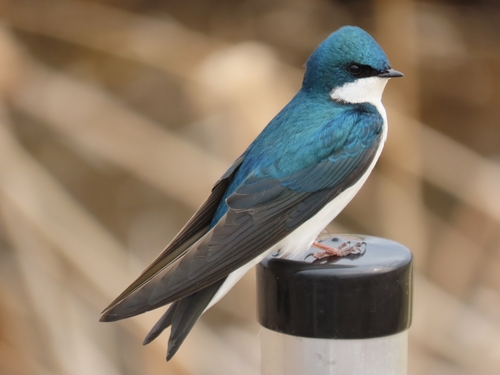
Tree Swallow
The Tree Swallow (Tachycineta bicolor) is a migratory bird known for its iridescent blue-green upperparts and contrasting white underparts. These agile fliers are a common sight across North America, often seen swooping and gliding over fields and water bodies in pursuit of insects. Ecologically, they play a crucial role in controlling insect populations. While not holding significant cultural importance in the same way as some other bird species, their arrival is often seen as a harbinger of spring, and their cavity-nesting habits make them frequent users of nest boxes provided by humans.
12-15 cm
Length
29-33 cm
Wingspan
Least Concern
Conservation Status
Distribution
Breeds across North America, from Alaska and Canada south to the central and southern United States. Winters in the southern United States, Mexico, Central America, and the Caribbean. Migratory routes vary, but generally follow coastlines and major river valleys.
Lifespan
Average lifespan in the wild is 2-3 years, but individuals can live up to 12 years.
Tree Swallow's Habitat
Habitat Types
Open woodlands, Fields, Marshes, Meadows, Areas near water
Climate Zones
Temperate, Subarctic, Subtropical
Adaptations
Tree Swallows are cavity nesters, relying on pre-existing holes in trees or nest boxes. This adaptation allows them to breed in areas with limited natural nesting sites. Their streamlined bodies and long, pointed wings are adaptations for efficient aerial foraging.
Variations
No recognized subspecies, though some slight variations in plumage brightness and size may occur across their vast range. These variations are not significant enough to warrant subspecies classification.
Appearance
Breeding Plumage
Adult males have iridescent blue-green upperparts and bright white underparts. Females are similar but often duller, with more brown tones in their upperparts. Juveniles are brownish-gray above and white below. Plumage is generally consistent year-round, with minor wear and fading.
Seasonal Feather Changes
Limited seasonal variation, with plumage becoming slightly duller after breeding season due to feather wear.
Sex Based Plumage Differences
Males are typically more brightly colored than females.
Notable Features
Iridescent blue-green upperparts, Bright white underparts, Deeply forked tail, Small, pointed bill
Diet and Feeding
Primary Foods
Flying insects, Spiders, Some berries and seeds (especially during winter)
Foraging Behavior
Primarily forages in flight, catching insects on the wing. They often fly low over water or fields, using their agility to pursue prey. They may also glean insects from vegetation.
Specializations
Their wide gape and maneuverability are specializations for catching insects in flight. Their ability to switch to a diet of berries and seeds during periods of insect scarcity is a crucial adaptation for survival.
Seasonal Diet Variations
Diet is primarily insects during the breeding season. In winter, when insects are less available, they consume more berries and seeds, particularly bayberries.
Behavior
Social Structure
Highly social, especially outside of the breeding season. Often forms large flocks for migration and roosting.
Communication
Variety of calls, including chirps, twitters, and chatters, Aerial displays during courtship and territorial disputes
Migration
Long-distance migrants, traveling between breeding grounds in North America and wintering grounds in the southern US, Mexico, and Central America. Migration often occurs in large flocks.
Territorial or Group Behaviors
During the breeding season, males are territorial around nest sites. Outside of breeding, they are highly social and form large flocks.
Conservation
Threats
Habitat loss (loss of nesting cavities), Pesticide use (reducing insect prey), Climate change (affecting insect emergence and migration timing)
Protection Programs
Provision of nest boxes, Habitat conservation and restoration efforts, Monitoring programs (e.g., Breeding Bird Survey)
Local National Laws
Protected under the Migratory Bird Treaty Act in the United States and similar legislation in Canada and Mexico.
Population Trend
Stable
Population Estimates
Global population estimated at 19 million.
Interesting Facts
They often line their nests with feathers from other bird species.
This provides insulation and may help regulate nest temperature.
Tree Swallows are known to engage in 'extra-pair copulations'.
This means that females may mate with males other than their social partner.
They can tolerate colder temperatures than most other swallow species.
This allows them to arrive earlier on their breeding grounds and breed earlier in the season.
Faqs about Tree Swallow
What do I do if I find a baby Tree Swallow?
If the bird is injured or clearly orphaned, contact a local wildlife rehabilitator. Do not attempt to care for it yourself, as they have specific dietary and care needs. *Consult a professional for expert advice.*
How can I attract Tree Swallows to my yard?
Provide nest boxes with appropriate dimensions and placement. Maintain open areas and avoid pesticide use.
Do Tree Swallows return to the same nest site each year?
They often show site fidelity, returning to the same area or even the same nest box, but this is not always guaranteed.
Copyright @ Nature Style Limited. All Rights Reserved.
 English
English